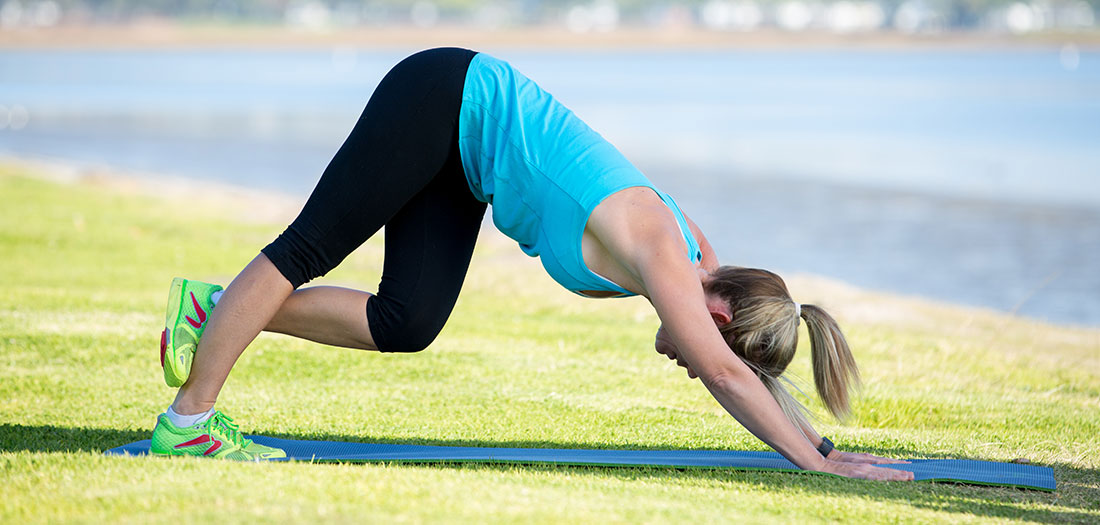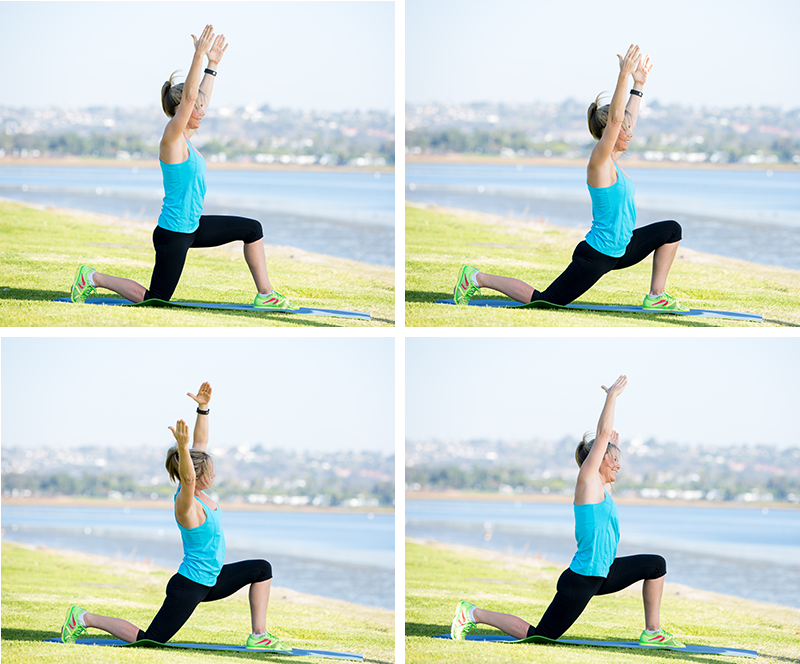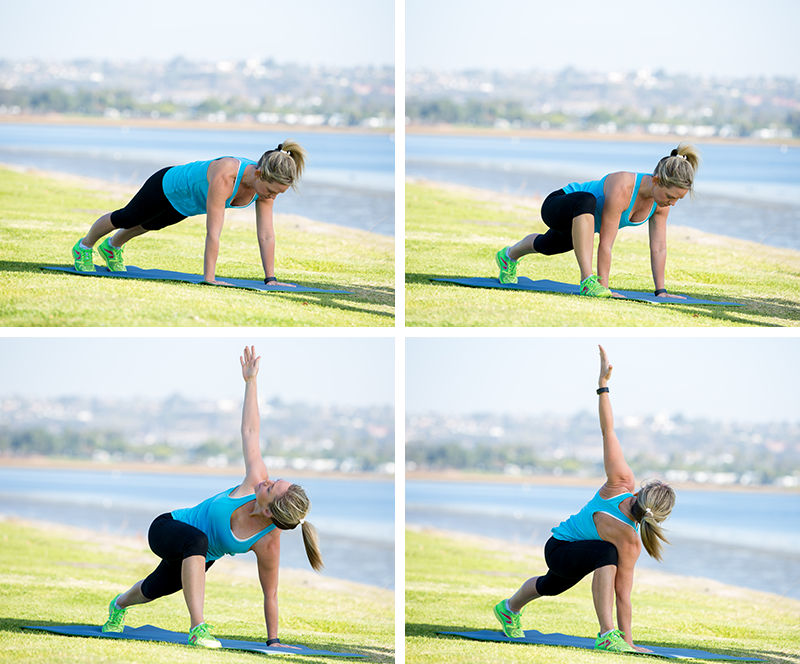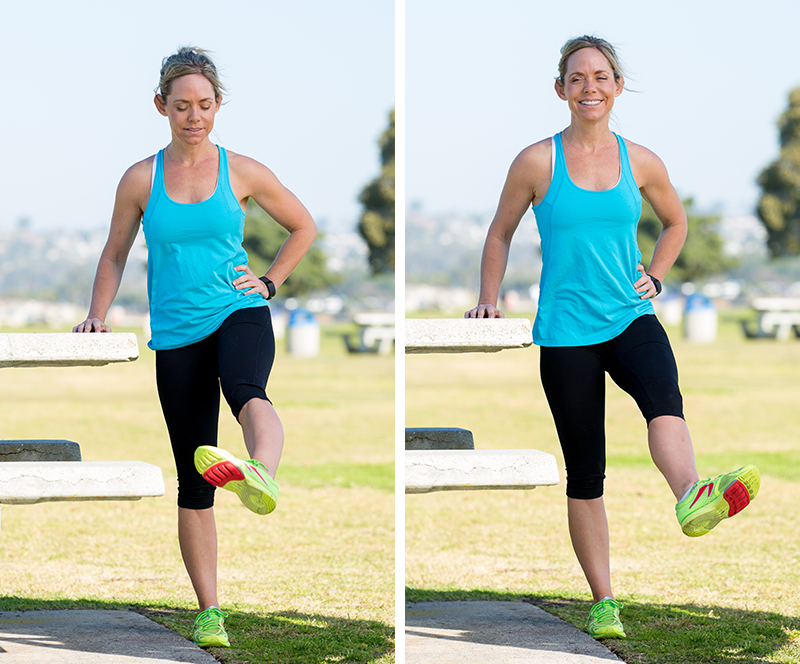4 Stretches to Prevent Injury
Over the past 30 years, stretching has transitioned from a must-do before exercise, to a must-do after exercise to a shunned exercise. Today, however, some are promoting it as an effective injury-prevention practice.
So, does stretching prevent injury? A short disclaimer before we delve too deeply into this question: No practice or modality truly prevents an injury. All sports and activities have inherent risks and some injuries are unavoidable. But a proper warm-up before activity (which may or may not include stretching) is the best way to reduce the risk of injury.
To answer the million-dollar question above, we must also define “stretching” because static, dynamic and ballistic stretching each differ from one another. Further, how trainers utilize stretching in training or pre-competition (versus research protocols) also differs. Research over the last 10 or more years suggests that stretching does not positively affect injury risk. Additionally, research concludes that static stretching can significantly decrease power output and can, in some cases, increase injury risk. As a result, dynamic stretching has been the accepted approach to flexibility, while static stretching has been largely exiled to yoga studios.
Clearly, if you are lining up at the 100-meter starting line, spending 15 minutes performing a number of stretches that you hold for 30 seconds each will make you slower. But reaching down and touching your toes for three seconds (technically a static stretch) is unlikely to affect your explosiveness out of the blocks.
In short, a one-size-fits-all approach to stretching (or flexibility training) does not exist and the “four best stretches to prevent injury” are the four stretches you (or your clients) need the most. Any stretch is only as good as the stability exercise that follows it. Therefore, the best way to use stretching as part of an injury-prevention program is to either stretch (mobilize) and then strengthen (stabilize) a joint or perform exercises that integrate both mobility and stability.
Thus, static stretching can help prevent injury risk if it increases mobility. Improving mobility allows for better positioning, which allows for enhanced movement, which leads to improved coordination, power and strength, and decreased risk of injury.
The following exercises target areas of need for most people: calves, hips and posterior chain (hamstrings and spine).
Over the past 30 years, stretching has transitioned from a must-do before exercise, to a must-do after exercise to a shunned exercise. Today, however, some are promoting it as an effective injury-prevention practice.
So, does stretching prevent injury? A short disclaimer before we delve too deeply into this question: No practice or modality truly prevents an injury. All sports and activities have inherent risks and some injuries are unavoidable. But a proper warm-up before activity (which may or may not include stretching) is the best way to reduce the risk of injury.
To answer the million-dollar question above, we must also define “stretching” because static, dynamic and ballistic stretching each differ from one another. Further, how trainers utilize stretching in training or pre-competition (versus research protocols) also differs. Research over the last 10 or more years suggests that stretching does not positively affect injury risk. Additionally, research concludes that static stretching can significantly decrease power output and can, in some cases, increase injury risk. As a result, dynamic stretching has been the accepted approach to flexibility, while static stretching has been largely exiled to yoga studios.
Clearly, if you are lining up at the 100-meter starting line, spending 15 minutes performing a number of stretches that you hold for 30 seconds each will make you slower. But reaching down and touching your toes for three seconds (technically a static stretch) is unlikely to affect your explosiveness out of the blocks.
In short, a one-size-fits-all approach to stretching (or flexibility training) does not exist and the “four best stretches to prevent injury” are the four stretches you (or your clients) need the most. Any stretch is only as good as the stability exercise that follows it. Therefore, the best way to use stretching as part of an injury-prevention program is to either stretch (mobilize) and then strengthen (stabilize) a joint or perform exercises that integrate both mobility and stability.
Thus, static stretching can help prevent injury risk if it increases mobility. Improving mobility allows for better positioning, which allows for enhanced movement, which leads to improved coordination, power and strength, and decreased risk of injury.
The following exercises target areas of need for most people: calves, hips and posterior chain (hamstrings and spine).
Prone Calf Stretch
 In a prone position, place the left foot over the right heel. Walk the hands toward the feet and stick the hips in the air until the right foot is completely flat on the floor. Keep the right heel down and the right knee straight. Slowly rock the hips from side to side, keeping the right heel down. Drive 10 times to each side and repeat on the left leg.
Modifications: Hands against a wall; hands on 12-24” box; slightly bent knee (to target the soleus)
In a prone position, place the left foot over the right heel. Walk the hands toward the feet and stick the hips in the air until the right foot is completely flat on the floor. Keep the right heel down and the right knee straight. Slowly rock the hips from side to side, keeping the right heel down. Drive 10 times to each side and repeat on the left leg.
Modifications: Hands against a wall; hands on 12-24” box; slightly bent knee (to target the soleus)

In a prone position, place the left foot over the right heel. Walk the hands toward the feet and stick the hips in the air until the right foot is completely flat on the floor. Keep the right heel down and the right knee straight. Slowly rock the hips from side to side, keeping the right heel down. Drive 10 times to each side and repeat on the left leg.
Modifications: Hands against a wall; hands on 12-24” box; slightly bent knee (to target the soleus)
Kneeling Hip Stretch
 In a half-kneeling position, reach the arms overhead while pushing the hips slightly forward (keep the thigh perpendicular to the floor). Complete five to 10 overhead arm drives and then reach over the right shoulder and the left shoulder, five to 10 times on each side. Repeat on the other side.
Modifications: Place hands on the hips (if you experience low-back pain); prop the rear foot onto a 12” box or chair (this modification increases the stretch on the rectus femoris)
In a half-kneeling position, reach the arms overhead while pushing the hips slightly forward (keep the thigh perpendicular to the floor). Complete five to 10 overhead arm drives and then reach over the right shoulder and the left shoulder, five to 10 times on each side. Repeat on the other side.
Modifications: Place hands on the hips (if you experience low-back pain); prop the rear foot onto a 12” box or chair (this modification increases the stretch on the rectus femoris)

In a half-kneeling position, reach the arms overhead while pushing the hips slightly forward (keep the thigh perpendicular to the floor). Complete five to 10 overhead arm drives and then reach over the right shoulder and the left shoulder, five to 10 times on each side. Repeat on the other side.
Modifications: Place hands on the hips (if you experience low-back pain); prop the rear foot onto a 12” box or chair (this modification increases the stretch on the rectus femoris)
Spiderman With a Twist
 Start in a push-up position. Bring the right foot to the outside of the right hand. Keep the right foot completely flat and the left leg completely extended. Slowly drive the hips from side to side five to 10 times each. Rest the left knee on the floor and reach the left arm up and back. Hold for a 2-count and bring it back to the floor. Reach the right arm up and back and hold for a 2-count. Next, walk both hands forward (keeping he right foot in place) until you are back to a push-up position. Repeat on the left side and complete five reps (or cover 10-15 yards).
Modifications: Thread the needle pose, Supine spinal twist with legs crossed
Start in a push-up position. Bring the right foot to the outside of the right hand. Keep the right foot completely flat and the left leg completely extended. Slowly drive the hips from side to side five to 10 times each. Rest the left knee on the floor and reach the left arm up and back. Hold for a 2-count and bring it back to the floor. Reach the right arm up and back and hold for a 2-count. Next, walk both hands forward (keeping he right foot in place) until you are back to a push-up position. Repeat on the left side and complete five reps (or cover 10-15 yards).
Modifications: Thread the needle pose, Supine spinal twist with legs crossed

Start in a push-up position. Bring the right foot to the outside of the right hand. Keep the right foot completely flat and the left leg completely extended. Slowly drive the hips from side to side five to 10 times each. Rest the left knee on the floor and reach the left arm up and back. Hold for a 2-count and bring it back to the floor. Reach the right arm up and back and hold for a 2-count. Next, walk both hands forward (keeping he right foot in place) until you are back to a push-up position. Repeat on the left side and complete five reps (or cover 10-15 yards).
Modifications: Thread the needle pose, Supine spinal twist with legs crossed
Leg Kicks/Swings
 Hold onto a wall or fence with the left hand while balancing on the left foot. Point the right toes forward, but keep the foot relaxed. Swing the right leg forward (driving from the hips) 10 times. Repeat with the right toes pointed outward and again with the toes pointed inward. Face the other way and repeat on the left side.
Modifications: Lying on the floor, Supine hamstring stretch
Hold onto a wall or fence with the left hand while balancing on the left foot. Point the right toes forward, but keep the foot relaxed. Swing the right leg forward (driving from the hips) 10 times. Repeat with the right toes pointed outward and again with the toes pointed inward. Face the other way and repeat on the left side.
Modifications: Lying on the floor, Supine hamstring stretch
 JUSTIN ROBINSONContributor
Justin Robinson is a Registered Sports Dietitian and Strength and Conditioning Coach who has worked with athletes from youth to professional level. As the nutrition director and co-founder of Venn Performance Coaching, he specializes in practical sports nutrition recommendations and functional conditioning techniques. Over the past 15 years, he has worked with athletes from the youth to professional level, including runners and triathletes, MLB players and U.S. Military Special Operations soldiers. He graduated from Cal Poly, San Luis Obispo with a dual degree in Nutrition and Kinesiology, completed his dietetic internship at the University of Houston and earned his Master's Degree in Kinesiology at San Diego State University.
JUSTIN ROBINSONContributor
Justin Robinson is a Registered Sports Dietitian and Strength and Conditioning Coach who has worked with athletes from youth to professional level. As the nutrition director and co-founder of Venn Performance Coaching, he specializes in practical sports nutrition recommendations and functional conditioning techniques. Over the past 15 years, he has worked with athletes from the youth to professional level, including runners and triathletes, MLB players and U.S. Military Special Operations soldiers. He graduated from Cal Poly, San Luis Obispo with a dual degree in Nutrition and Kinesiology, completed his dietetic internship at the University of Houston and earned his Master's Degree in Kinesiology at San Diego State University.

Hold onto a wall or fence with the left hand while balancing on the left foot. Point the right toes forward, but keep the foot relaxed. Swing the right leg forward (driving from the hips) 10 times. Repeat with the right toes pointed outward and again with the toes pointed inward. Face the other way and repeat on the left side.
Modifications: Lying on the floor, Supine hamstring stretch
 JUSTIN ROBINSONContributor
JUSTIN ROBINSONContributor
Justin Robinson is a Registered Sports Dietitian and Strength and Conditioning Coach who has worked with athletes from youth to professional level. As the nutrition director and co-founder of Venn Performance Coaching, he specializes in practical sports nutrition recommendations and functional conditioning techniques. Over the past 15 years, he has worked with athletes from the youth to professional level, including runners and triathletes, MLB players and U.S. Military Special Operations soldiers. He graduated from Cal Poly, San Luis Obispo with a dual degree in Nutrition and Kinesiology, completed his dietetic internship at the University of Houston and earned his Master's Degree in Kinesiology at San Diego State University.
Comments
Post a Comment